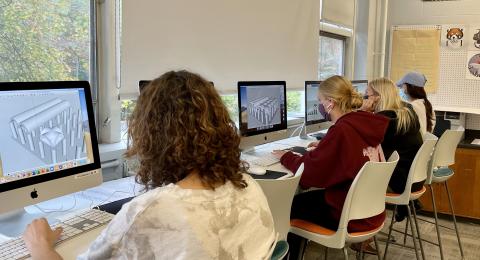What is art history, design and computer sciences?
In this program, you’ll develop basic skills in art history and design as well as computer programming and then apply those skills to projects related to museum collections management and visitor experience, research projects, website design for cultural institutions, or art market intelligence and data transparency. You’ll combine your learning in creative ways and with emerging technologies such as augmented reality, virtual reality, 3D modelling and more traditional website design. You’ll learn how emerging technologies can come together with the art market as well as cultural heritage to help document, preserve, investigate and present it for future generations.
Why study art history, design and computer sciences at UNH?
This cognate offers the benefit of being a structured yet flexible undergraduate program, and your course of study can be tailored to your interests. You’ll draw on the expertise of UNH faculty from art history, design and computer science with high degrees
Potential career areas
- Archival work
- Arts
- Auction houses
- Cultural Institutions
- Curation
- Education
- Galleries
- Multimedia arts
- Museum work
- Nonprofit organizations
Curriculum & Requirements
The cognate is for students to develop basic skills in art history and design as well as computer programming. The aim is for them to be able to apply programming skills to develop projects related to museum collections management and visitor experience, research projects, website design for cultural institutions, and art market intelligence and data transparency. Students will be encouraged to learn the basic concepts of art history and design and combine them in creative ways with emerging technologies such as Augmented Reality, Virtual Reality, 3D modelling and more traditional website design. The aim is to give students a head start on how emerging technologies can come together with the art market as well as cultural heritage to help document, preserve, investigate and present it for future generations.
The cognate consists of completing three courses in total (12 credits) selected from the list below, preferably completed in the order listed.
| Code | Title | Credits |
|---|---|---|
| Required Courses | ||
| 1. Arts | ||
| Select one course from the following: | 4 | |
ARTH 440A | From Digging to Digital: Preserving and Displaying the Past | |
ARTH 474 | Introduction to Architectural History | |
ARTH 480 | Introduction to Art History | |
ARTS 510 | Principles of Design | |
| 2. Computer Sciences | ||
| Select one course from the following: | 4 | |
CS 408 | Living in a Networked World: The Good, the Bad, and the Ugly | |
CS 410P | Introduction to Scientific Programming/Python | |
CS 415 | Introduction to Computer Science I | |
CS 457 | Introduction to Data Science and Analytics | |
IT 403 | Introduction to Internet Technologies | |
| 3. Digital Applications 1 | ||
| Select one course from the following: | 4 | |
ARTH 674 | Greek Art and Architecture | |
ARTH 699 | Museum Studies | |
HIST 771 | Museum Studies | |
Any other 600-level Art History course, by permission (WI) | ||
| Total Credits | 12 | |
- 1
Students should aim to complete a project focused on digital applications.




